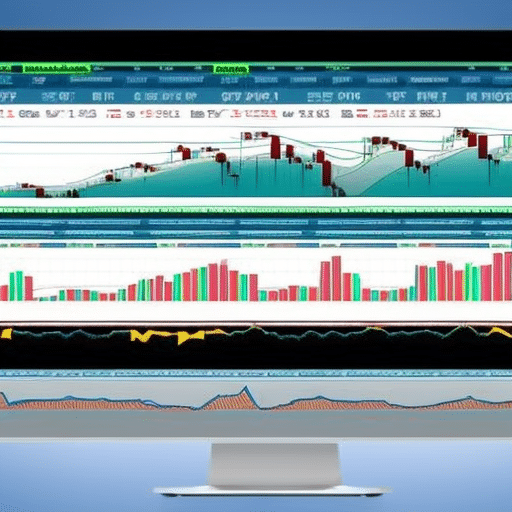In the fast-paced world of cryptocurrency trading, understanding market conditions and predicting future trends is essential for success. This article explores the realm of trading indicators, crucial statistics used in technical analysis to analyze price patterns and trends. We will delve into common indicators such as moving averages, MACD, and RSI, and discuss their suitability for different trading styles. Additionally, we shed light on additional indicators and metrics like OBV, social media indicators, Bitcoin dominance, and Bitcoin hash rate. Join us as we unveil the secrets behind these master indicators and equip you with the knowledge to navigate cryptocurrency trading with confidence.
Table of Contents
ToggleUnderstanding Cryptocurrency Indicators
The understanding of cryptocurrency indicators is crucial for successful trading in the crypto market. Indicators are statistics used in technical analysis to comprehend market conditions and predict future trends. Technical analysis focuses on price patterns and trends, which helps traders select a suitable trading strategy. Common indicators in cryptocurrency trading include moving averages (MA), MACD, and RSI. Moving averages indicate the trend direction and help identify support, resistance, and trend reversals. MACD is a popular momentum indicator that shows the difference between short and long period exponential moving averages. It provides buy or sell signals based on its position relative to the zero line. Other cryptocurrency trading indicators include the Relative Strength Index (RSI), social media indicators, and fear and greed index. Traders can personalize their indicator selection based on their trading style and preferences. Additional indicators and metrics include On-Balance-Volume (OBV), social media activity, Bitcoin dominance, and Bitcoin hash rate.
Moving Average (MA) for Trend Analysis
Moving Average’s (MA) role in trend analysis is crucial for understanding market conditions and predicting future trends in cryptocurrency trading. Moving averages are calculated by taking the average price of an asset over a specific period. They help traders identify the direction of a trend, whether it is bullish or bearish. Simple moving averages (SMA) are commonly used by long-term traders, while exponential moving averages (EMA) are preferred by short-term traders. The most frequently used moving averages in cryptocurrency trading are the 200, 50, and 20-period averages. Moving averages also assist in identifying support and resistance levels, as well as potential trend reversals. By analyzing the relationship between different moving averages, traders can gain valuable insights into market trends and make informed trading decisions.
Utilizing MACD Indicator for Momentum
Utilizing the MACD indicator for momentum analysis is essential in understanding market conditions and making informed trading decisions in cryptocurrency trading. The MACD (Moving Average Convergence Divergence) is a popular momentum indicator that shows the difference between short and long period exponential moving averages. Here are three key points to consider when using the MACD indicator:
- MACD divergence indicates moving averages moving apart, while convergence shows them coming together. This can help identify the strength of a trend.
- Positive MACD indicates bullish momentum, while negative MACD indicates bearish momentum. Traders can use this information to determine when to buy or sell.
- The MACD chart can help assess the strength of the current trend. Divergences between price and MACD can signal potential trend reversals.
Exploring Relative Strength Index (RSI)
When analyzing market conditions and making informed trading decisions in cryptocurrency trading, one must explore the Relative Strength Index (RSI). The RSI is a technical indicator that measures the speed and change of price movements. It oscillates between 0 and 100 and is commonly used to identify overbought and oversold conditions in the market. Traders can use the RSI to determine whether an asset is overvalued or undervalued and anticipate potential price reversals. When the RSI is above 70, it indicates that the asset is overbought and a correction may be imminent. Conversely, when the RSI is below 30, it suggests that the asset is oversold and a rebound may occur. By incorporating the RSI into their analysis, traders can gain valuable insights into market conditions and improve their trading strategies.
Harnessing Social Media Indicators
To leverage social media indicators in cryptocurrency trading, traders can analyze sentiment and discussions on various platforms. Social media has become a powerful tool for gathering real-time information and understanding market sentiment. Here are three ways traders can harness social media indicators:
-
Sentiment Analysis: By analyzing the overall sentiment of social media posts and discussions, traders can gauge market sentiment towards a particular cryptocurrency. Positive sentiment may indicate a bullish trend, while negative sentiment may suggest a bearish trend.
-
Trend Identification: Social media platforms can provide insights into emerging trends and hot topics in the cryptocurrency space. Traders can monitor hashtags, discussions, and influential figures to identify potential investment opportunities or market shifts.
-
News and Events Tracking: Social media platforms are often the first to report breaking news and events related to cryptocurrencies. Traders can stay updated with the latest developments, such as regulatory changes or partnerships, which may impact the market.
Unveiling Fear and Greed Index
The Fear and Greed Index in cryptocurrency trading provides valuable insights into market sentiment and investor behavior. It is a popular indicator that measures the emotions of market participants, ranging from extreme fear to extreme greed. This index is calculated using various factors such as volatility, market momentum, social media trends, and surveys. By analyzing this index, traders can gain a better understanding of the overall market sentiment and make informed decisions.
Here is an example of how the Fear and Greed Index can be displayed in a table format:
| Fear and Greed Level | Description | Market Behavior |
|---|---|---|
| Extreme Fear | Investors are pessimistic and fearful. | Prices may be undervalued, indicating a buying opportunity. |
| Fear | Investors are cautious and uncertain. | Prices may be lower, but with potential for further decline. |
| Greed | Investors are optimistic and bullish. | Prices may be overvalued, indicating a selling opportunity. |
On-Balance-Volume (OBV) for Price Breakouts
The On-Balance-Volume (OBV) indicator is a valuable tool in cryptocurrency trading for identifying price breakouts. This momentum indicator measures the cumulative volume of an asset relative to its price movements. Here are three key points about OBV:
- OBV helps traders identify price breakouts by analyzing the relationship between volume and price. When the OBV line is trending upwards, it suggests an increase in buying pressure and the potential for a bullish breakout. Conversely, a downward trending OBV line indicates selling pressure and a potential bearish breakout.
- OBV can confirm the strength of a price trend. If the OBV line is rising while the price is also increasing, it suggests a strong uptrend. On the other hand, if the OBV line is falling while the price is rising, it may indicate a weakening trend and a possible trend reversal.
- Divergences between the OBV line and price movements can provide valuable insights. For example, if the price is making higher highs but the OBV line is making lower highs, it may indicate a potential bearish divergence and a forthcoming price reversal.
Social Media Buzz and Google Trends
Social media buzz and Google Trends play a crucial role in understanding market sentiment and assessing the popularity of cryptocurrencies. In the cryptocurrency space, social media platforms like Twitter and Reddit have become important sources of information and discussion. Traders and investors closely monitor social media activity to gauge the overall sentiment towards specific cryptocurrencies. Positive sentiment can drive up prices, while negative sentiment can lead to price declines. Google Trends is also a valuable tool that provides insights into the search volumes for different cryptocurrencies. By analyzing the search trends, traders can identify which cryptocurrencies are gaining popularity and attracting more attention from potential investors. This information can be used to inform trading strategies and make more informed investment decisions. Overall, monitoring social media buzz and Google Trends can provide valuable insights into market sentiment and help traders stay ahead of market trends.
Analyzing Bitcoin Dominance
Analyzing Bitcoin dominance is essential for understanding the overall market dynamics and the influence of Bitcoin on the cryptocurrency space. Here are three key points to consider when analyzing Bitcoin dominance:
-
Market Influence: Bitcoin dominance measures the ratio of Bitcoin’s market capitalization to the total market capitalization of all cryptocurrencies. It provides insights into the market’s perception and acceptance of Bitcoin as the dominant cryptocurrency.
-
Alt Season Indications: Changes in Bitcoin dominance can indicate an alt season, which refers to a bull market for altcoins. When Bitcoin dominance decreases, it may signal that investors are diversifying their holdings into other cryptocurrencies.
-
Market Sentiment: Bitcoin dominance influences the whole market, making it a crucial metric for assessing market sentiment. A rising Bitcoin dominance may indicate a more cautious market sentiment, while a declining Bitcoin dominance may suggest increased risk appetite among investors.
Assessing Bitcoin Hash Rate
When evaluating the health of the Bitcoin network and its potential impact on the cryptocurrency market, it is important to assess the current Bitcoin hash rate. The hash rate represents the computing power used by miners to create new blocks and process transactions. A higher hash rate indicates a more secure and robust network, as it requires more computational power to attack the network. Additionally, a higher hash rate suggests increased mining activity and competition among miners. However, it is crucial to note that while the hash rate has shown some correlation with Bitcoin’s price in the past, it should not be relied upon as a precise price predictor. Instead, it provides insights into the overall network strength and miner participation, which can indirectly influence market sentiment and confidence in Bitcoin.
Personalizing Indicator Selection
With the aim of tailoring indicator selection to individual trading preferences, traders can personalize their choice of indicators based on their preferred trading style. Here are three important considerations when personalizing indicator selection:
-
Understanding the trading style: Traders should first determine their trading style, whether it’s day trading, swing trading, or long-term investing. Each style requires specific indicators that align with the trader’s goals and time horizon.
-
Identifying key market factors: Traders need to identify the key factors that influence the cryptocurrency market, such as volatility, volume, and trend strength. By selecting indicators that capture these factors, traders can make more informed trading decisions.
-
Testing and adapting: It’s crucial for traders to test different indicators and strategies to assess their effectiveness. By tracking performance and making adjustments based on market conditions, traders can refine their indicator selection over time.
Importance of Social Analytics
Social analytics play a crucial role in understanding market sentiment and making informed trading decisions in the cryptocurrency space. As the popularity of cryptocurrencies continues to grow, social media platforms have become a hub for discussions, news, and opinions about various digital assets. Cryptocurrency social media indicators analyze sentiment and discussions on platforms like Reddit and Twitter to gauge the overall market sentiment towards a particular cryptocurrency. These indicators can provide valuable insights into the potential price movements and trends. Additionally, social media activity and search traffic can also provide indications of rising or falling prices. By monitoring social analytics, traders can gain a better understanding of market sentiment and make more informed decisions when it comes to buying or selling cryptocurrencies.
The Role of Social Media in Altcoin Market
As the altcoin market continues to evolve, the influence of social media on investor sentiment and trading decisions remains a significant factor to consider. Social media platforms have become powerful tools for traders and investors to gather information, share insights, and gauge market sentiment. Here are three key roles that social media plays in the altcoin market:
-
Information Dissemination: Social media platforms allow for the rapid dissemination of news, updates, and analysis related to altcoins. Traders can stay informed about new projects, partnerships, regulatory developments, and market trends in real-time.
-
Sentiment Analysis: Social media provides a wealth of data to analyze investor sentiment towards specific altcoins. By monitoring discussions, comments, and reactions, traders can gain insights into market expectations, potential price movements, and overall market sentiment.
-
Influencer Effect: Social media influencers, such as prominent traders, analysts, and industry experts, can have a significant impact on altcoin prices. Their opinions and recommendations can sway investor sentiment and trigger buying or selling activity.
Analyzing Cryptocurrency Market Sentiment
To effectively analyze cryptocurrency market sentiment, traders can employ various indicators and metrics. These tools help traders understand the overall mood and emotions of market participants, which can be crucial in making informed trading decisions. One such indicator is the Relative Strength Index (RSI), which measures the speed and change of price movements. RSI values above 70 indicate overbought conditions, suggesting a potential reversal or correction, while values below 30 indicate oversold conditions, signaling a possible upward price movement. Additionally, cryptocurrency social media indicators analyze sentiment and discussions on social platforms. These indicators provide insights into the market sentiment and can help traders gauge the overall sentiment towards a particular cryptocurrency. By utilizing these indicators, traders can gain valuable insights into market sentiment and make more informed trading decisions.
Additional Metrics and Indicators
Building on the previous discussion of analyzing cryptocurrency market sentiment, it is important to consider additional metrics and indicators that can provide valuable insights for traders. These metrics and indicators can help traders make more informed decisions and improve their trading strategies. Here are three additional metrics and indicators to consider:
-
On-Balance-Volume (OBV): This momentum indicator is credible for cryptocurrencies and can indicate price breakout directions and money flow. Increasing OBV suggests price momentum picking up, while decreasing OBV indicates selling pressure and a potential bearish sentiment.
-
Social Media Indicators: Social media activity and search traffic can provide indications of rising or falling prices. Tools like Google Trends can track cryptocurrency social buzz and assess search volumes. Social analytics platforms aggregate data from popular cryptocurrency sources like Reddit and Twitter, providing valuable insights into market sentiment.
-
Bitcoin Dominance: This metric measures the ratio of Bitcoin’s market capitalization to the total market capitalization of all cryptocurrencies. Changes in Bitcoin dominance can indicate an alt season (bull market for altcoins) and influence the entire market.
Frequently Asked Questions
How Can Social Media Indicators Be Used to Analyze the Cryptocurrency Market?
Social media indicators in cryptocurrency trading can be used to analyze market sentiment and gauge the level of interest in specific cryptocurrencies. By monitoring social media activity and sentiment, traders can identify potential price movements and make informed trading decisions.
What Is the Relationship Between Bitcoin Dominance and Altcoin Market Performance?
Bitcoin dominance measures the ratio of Bitcoin’s market capitalization to the total market capitalization of all cryptocurrencies. Changes in Bitcoin dominance can indicate an alt season (bull market for altcoins), influencing the performance of the altcoin market.
How Does the Bitcoin Hash Rate Impact the Health of the Bitcoin Network?
The bitcoin hash rate is a metric that assesses the health of the bitcoin network. It represents the computing power used by miners to create new blocks and process transactions, indicating the network’s security and efficiency.
What Are Some Additional Metrics and Indicators That Can Be Used in Cryptocurrency Trading?
Some additional metrics and indicators that can be used in cryptocurrency trading include On-Balance-Volume (OBV), social media indicators, Google Trends, Bitcoin dominance, and Bitcoin hash rate. These metrics provide insights into price momentum, market sentiment, and network health.
Why Is It Important for Traders to Personalize Their Indicator Selection Based on Their Trading Style and Preferences?
It is important for traders to personalize their indicator selection based on their trading style and preferences because different indicators are suitable for different strategies, allowing traders to effectively analyze market conditions and make informed trading decisions.






















